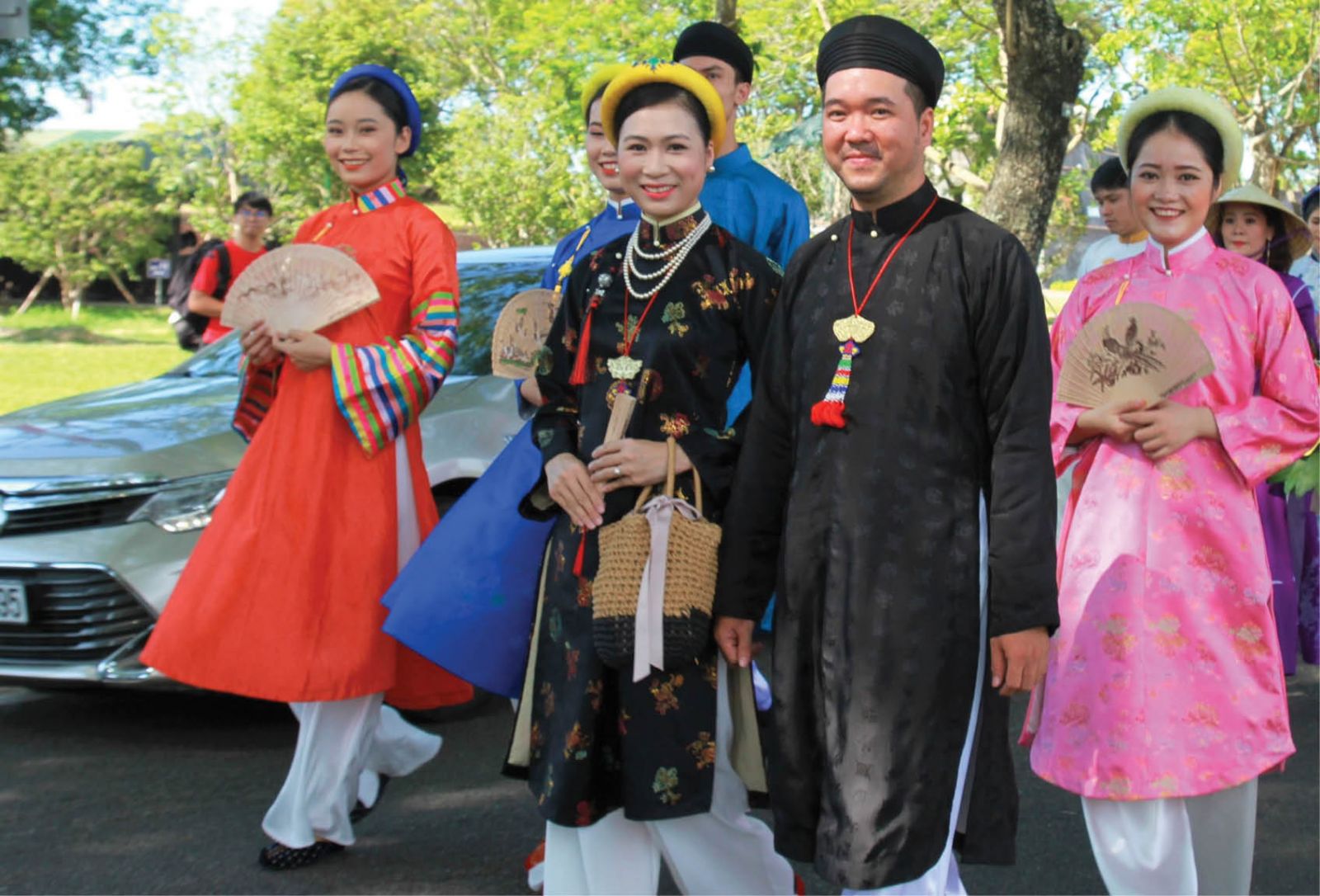
The five-panel ao dai is returning to our modern life.
Exquisite
The five-panel ao dai took shape in Lord Nguyen Phuc Khoat’s era and is considered the forerunner of the today’s ao dai. It is called the five-panel ao dai because it is the combination of five 5 pieces (or panels): 2 fronts, 2 opposite backs, and the 5th piece on the right inside, behind the first one.
According to the researcher Nguyen Xuan Hoa, it is said that Hue people think the five panels symbolize the five human moralities; the four panels on the front and at the back represent the four parents and parents-in-law while the inner body represents the son or daughter.
The five-panel ao dai also has five buttons symbolizing the five constant virtues (kindness, decorum, uprightness, wisdom and faithfulness,) or the five moral obligations (king and subject, father and child, husband and wife, brothers and sisters, among friends.) One who wears the five-panel ao dai carries human moralities and is not allowed to do wrong things.
Men's five-panel ao dai and women's are quite similar except for some details. The collar for women is smaller than for men; the sleeves for women are narrower; the flaps for men are longer. Both ao dai for men and women have five buttons along the body on the left and to the waist. The sleeves of the five-panel ao dai are narrower than those of ao tat and ao giao linh.
The fashion designer Quang Hoa says that the five-panel ao dai has two layers, outside and inside. It is comfortable, convenient, neat and discreet to wear. The design and texture of the five-panel ao dai makes men look formal and stately. As for women, it improves their figures and conceal their body defects. However, it is complicated to make a five-panel ao dai. The cost is hence higher than that of the conventional one.
“The way the five-panel ao dai is made and worn, especially the one for man, clearly shows such characteristics as modesty, discreetness, and exquisiteness,” said the painter Nguyen Duc Binh, Chairman of Dinh Lang Viet Club.
The exquisiteness is shown through sewing techniques so that patterns at edges match and stitches are fine, regular and straight, hidden at some places. The flaps are lively curved.
In terms of aesthetics, its flaps, collar, sleeves, buttons are carefully calculated so that the ao dai is both functional and aesthetic. In the process of making a five-panel ao dai, shaping the flaps is the most complicated step, because its beauty depends on this stage.
It should be popularized
With the traditional five-panel ao dai, it is important to wear it properly before thinking about wearing it beautifully. "The five-panel ao dai must be accompanied by the turban, the white coat inside and the loose light-colored trousers. If the five-panel ao dai is made of brocade, then it can go well with a voile overcoat,” stressed the painter Nguyen Duc Binh.
In Hue, there are still a number of artisans and tailors who know how to make the five-panel ao dai, but it is just a small number while it has not been popular for such a long time.
According to Nguyen Duc Binh, Thua Thien Hue should take measures to revive the career of sewing five-panel ao dai and form a team of skillful artisans so that their names and products are linked to the brand name “Hue _ Capital of Ao dai Viet Nam.” There should be a special policy to encourage skillful artisans to pass down their techniques.
Gladly, the five-panel ao dai has begun to get interest again with the appearance of the groups that love ancient costumes all over the country such as Dinh Lang Viet Club, Dai Viet Co Phong, Vietnam Co Phuc Hoi, etc. They help encourage culture lovers and young people to be interested in the five-panel ao dai. The five-panel ao dai is also worn by the Chairman of the Provincial People's Committee Phan Ngoc Tho on ceremonial and diplomatic occasions to honor the traditional costume.
The return of the five-panel ao dai is also the impetus for the fashion designer Nguyen Quang Hoa to learn how to properly make five-panel ao dai for men and women. His collection “Ancient Imprint” inspired by royal motifs is his effort to bring the five-panel ao dai back to the place where it was born.
“Fashion designers, artisans, tailors, and those who love ancient clothes in Hue should cooperate to build, develop and spread the trademark of the five-panel ao dai,” said Nguyen Quang Hoa.
Story and photo: MINH HIEN